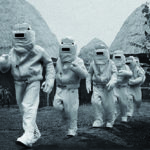 Humans
Humans  Humans
Humans  Animals
Animals 10 Animals That Humiliated and Harmed Historical Leaders
 History
History 10 Most Influential Protests in Modern History
 Creepy
Creepy 10 More Representations of Death from Myth, Legend, and Folktale
 Technology
Technology 10 Scientific Breakthroughs of 2025 That’ll Change Everything
 Our World
Our World 10 Ways Icelandic Culture Makes Other Countries Look Boring
 Misconceptions
Misconceptions 10 Common Misconceptions About the Victorian Era
 Mysteries
Mysteries 10 Strange Unexplained Mysteries of 2025
 Miscellaneous
Miscellaneous 10 of History’s Most Bell-Ringing Finishing Moves
 History
History 10 Great Escapes That Ended Right Back in Captivity
 Humans
Humans 10 Everyday Human Behaviors That Are Actually Survival Instincts
 Animals
Animals 10 Animals That Humiliated and Harmed Historical Leaders
 History
History 10 Most Influential Protests in Modern History
Who's Behind Listverse?

Jamie Frater
Head Editor
Jamie founded Listverse due to an insatiable desire to share fascinating, obscure, and bizarre facts. He has been a guest speaker on numerous national radio and television stations and is a five time published author.
More About Us Creepy
Creepy 10 More Representations of Death from Myth, Legend, and Folktale
 Technology
Technology 10 Scientific Breakthroughs of 2025 That’ll Change Everything
 Our World
Our World 10 Ways Icelandic Culture Makes Other Countries Look Boring
 Misconceptions
Misconceptions 10 Common Misconceptions About the Victorian Era
 Mysteries
Mysteries 10 Strange Unexplained Mysteries of 2025
 Miscellaneous
Miscellaneous 10 of History’s Most Bell-Ringing Finishing Moves
 History
History 10 Great Escapes That Ended Right Back in Captivity
10 Demons You Should Probably Try To Avoid
Since the dawn of time, men, women, and children alike have feared that which goes bump in the night. Such fears manifest in varied forms in various locations, but each story is kept alive by the universal bond of storytelling—generation to generation, these stories are told as a rite of passage for those old enough to doubt their authenticity. These stories, some of which many swear are true, serve as warnings to children who wish to go wandering through the woods alone or teenagers who feel invincible in the face of danger.
But what if these myths were not so mythical after all? If you were to happen across such a demonic creature on your travels, would you be prepared for its trickery, or would you fall prey to its evil ways? Whether or not you consider yourself a believer, perhaps it’s a good idea to hedge your bets and stay up-to-date with the beasts of the night.
10 Jinn/Jinni
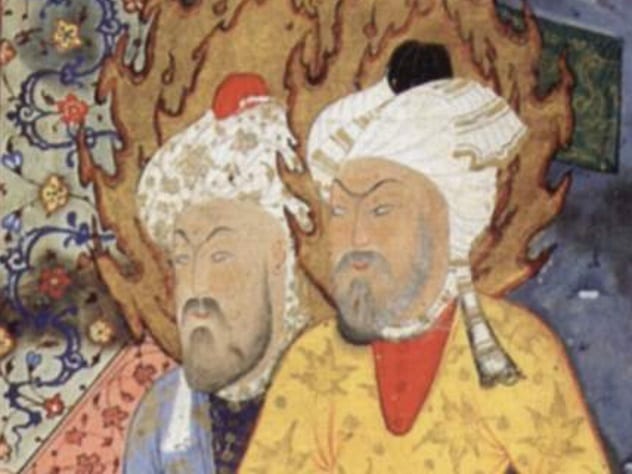
Also sometimes referred to as djinn, the jinn are ancient demons from Arabic and Islamic traditions. They are considered so mischievous and diabolical that they rank below devils in the divine lineup. Rumor has it that jinn, born from smokeless flame, are able to take human and animal forms at will.[1] When they wish to stir up trouble, they assume these forms as a way of blending in with the physical world and maintaining their ruse until they are ready to reveal their true form. You see, jinn live in a world parallel to the one humans know—this means that while jinn can see us all of the time, we cannot see jinn unless they wish to be seen. Part of their trickery stems from their inclination toward chaos and a penchant for revenge.
When not in human or animal form, jinn live in, well, anything: They can live in trees, rocks, streams, ruins—even your desk drawer! As such, you must be careful not to disturb a jinn for fear it might take offense and choose to seek revenge. A jinn does not care if your insult was accidental; it only cares about getting even. This revenge might manifest in a plague, disease, bodily possession, or even a freak accident. However, if you are careful and aware of their nature, it is quite simple to exploit and banish a jinn—one only has to pray for their demise.
9 Wendigo
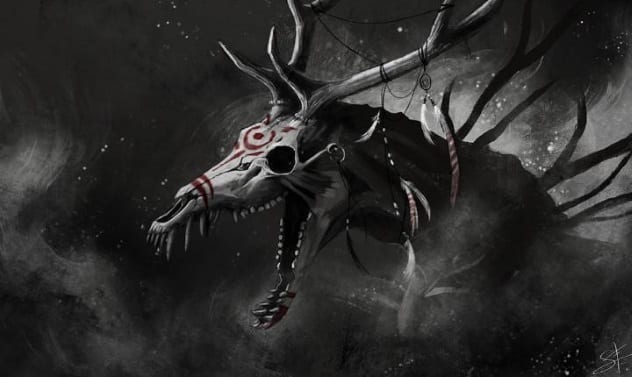
If you ever find yourself traversing through the Great Lakes Region of the US or the forests of Central Canada, then keep an eye out for the massive, skull-faced demon spirit with a heart of ice. The wendigo, which originates from the Algonquin tradition, is known to roam the forest in search of human prey, whom it then possesses or drives mad from isolation.[2]
The wendigo is a supernatural hunter—it uses its immense strength, speed, and endurance to hunt anyone who crosses into its territory. Sometimes, the wendigo even uses its ability to mimic human voices to call the name of its prey and lure an unsuspecting soul into the woods. Once caught by the wendigo, the unfortunate victim is possessed or driven to insanity, eventually turning into another wendigo.
This aspect of the legend is much more realistic than it might seem: Settlers and Native Americans who were stranded and lost in the dense wilderness would resort to cannibalism in the name of survival. Those who made it back to civilization were never the same again: This was dubbed “wendigo fever.” The wendigo, with its insatiable appetite, is the demonic embodiment of gluttony.
8 Krampus
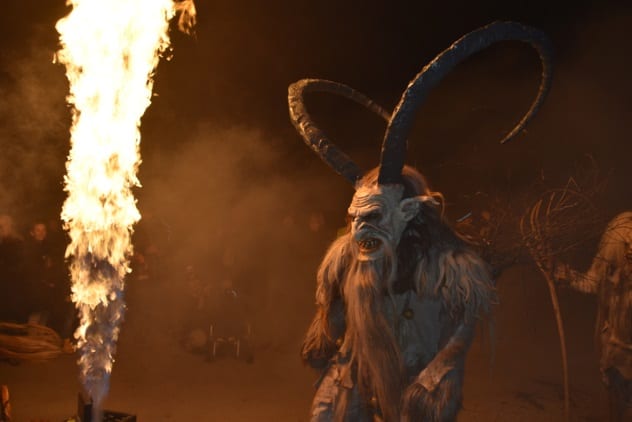
In typical Yuletide fashion, Santa Claus is celebrated for his generosity and kindness toward children, especially those who remain on the nice list the whole year through. But for Central European children, their incentive to stay away from the naughty list is a much more visceral one, stemming from their evil Santa Claus counterpart: Krampus. Each year on the night of December 5, the night before the beloved Saint Nicholas’s feast day, Krampus will emerge from his lair to torment villages until sunrise. If you were good, you would be rewarded with candy in your boot from Saint Nicholas. But if you were naughty, then Krampus would seek you out and swat you with his bundle of birch sticks. Sometimes, for especially wicked children, Krampus would stuff you in his sack and speed you away to his lair in the underworld.
It is said that Krampus is the half-goat half-demon son of the Norse god of the underworld, Hel. Between his infernal origins and his juxtaposition with Saint Nicholas, Krampus is the most fraught demon in Central European history. Ancient pagan dances, costumes, and rituals are still used today as a way to ward off the evil spirits of winter and their horned king.
7 Pocong
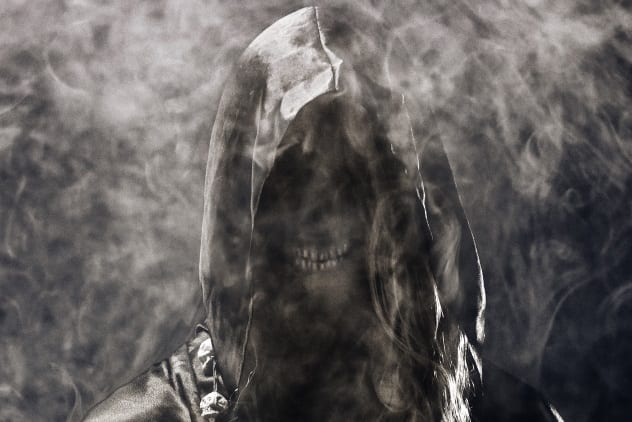
In Indonesia and Malaysia lurks a spirit intent on haunting cemeteries and abandoned houses. This spirit, known as the pocong in Indonesia and also as the hantu bungkus in Malaysia, has a pale, shriveled, eyeless face and a floating, decaying body.[4] The corpse is often shrouded in the translucent cloth used in Muslim burials.
In Islamic tradition, the shroud must be tied in three places—the head, behind the neck, and at the feet—so that the soul of the departed is anchored down during its remaining time on Earth. After 46 days, the ties are supposed to be removed so that the soul may be set free, but if they are not undone, then the soul is trapped on Earth. As a result, the soul becomes bitter and angry over its entrapment and spends its time on Earth tormenting and attacking anyone who blocks its path.
Because its feet remain bound, the pocong hops or rolls after its victims and often uses surprise attacks to cause car wrecks and freak accidents. If you should ever come across a pocong, the only way to avoid attack is to lie down and play dead or to run down a long, winding road until you are out of sight of the demon.
6 Asag
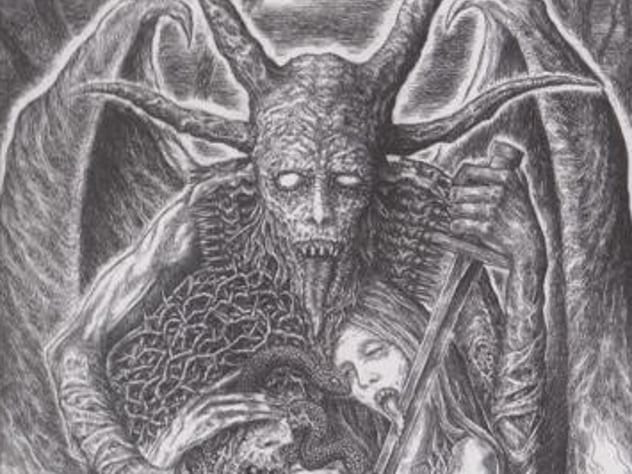
Originating from ancient Sumerian legend, Asag is a horrifying demon from the underworld whose personal mission is to thwart the god Ninurta. In order to do this, Asag created an army of rock demons that would do his bidding. Once defeated by Ninurta, Asag turned against humankind and began to prey on unsuspecting travelers.
Asag hunts after humans and rains disease and plague upon them.[5] He infests their very being and covers them like clothing, eventually paralyzing his victims with fever. When not preying on the innocent, Asag instead boils fish in their rivers and stirs up chaos in the form of landslides.
5 Manananggal
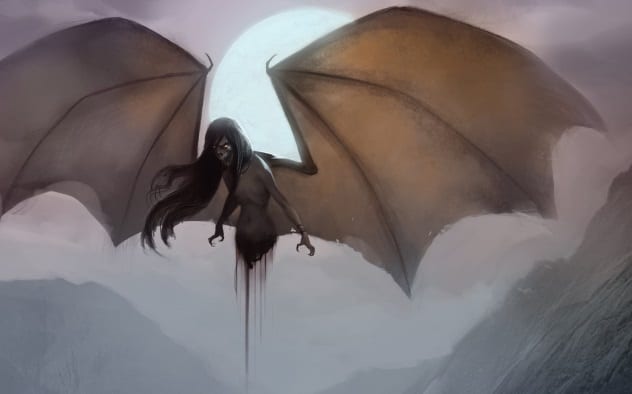
By day, this Filipino monster takes the form of a lovely woman—the better to entrance and capture her victims. Once the Sun goes down, however, this demon shows her true form: a batlike being with large, withered wings, the fangs of a vampire, and long, sharp claws.[6] In order to transform into her true self, the manananggal must sever her torso from her legs to sprout wings—trailing her innards around below. Although the manananggal preys upon men during the day, she targets pregnant women at night, drinking their blood and eating their babies’ organs.
This demonic beast prefers to hunt at night, specifically because it must reunite with the lower half of its body by sunrise—if it fails to do so, then the manananggal will be destroyed. Until daybreak, the only ways to ward off a manananggal are to carry salt, garlic, pungent spices, vinegar, daggers, the tails of stingrays, or holy water. These ingredients can also be used to destroy the manananggal in the night: Simply find its lower half and cover it in ash, salt, or garlic so that the creature cannot reunite with it before sunrise.
4 Dullahan
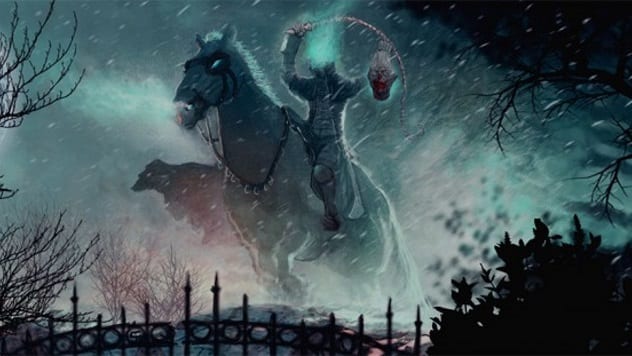
Akin to Sleepy Hollow’s Headless Horseman is Ireland’s Dullahan. The spirit of a man with a severed head, this black robe-clad rider hunts his prey in an unusual way. Instead of chasing and slaying his victims, the horseman serves as an omen of death: Whenever he stops riding, someone nearby will die. But if you hear your named called out by him, then you are surely his next victim. Thus, when the moon is full and the night is eerie, the Dullahan takes to Ireland’s country roads as a harbinger of death. Rarely, one may even find the Dullahan riding within a black carriage pulled by six black horses.[7]
If one should be so unfortunate as to see the Dullahan up close, they would discover his head tucked underneath an arm—or lifted high above the rider so that it may see miles into the dark night. In the other hand, the Dullahan carries a spine-like whip. On full moons, it is best to stay within your home, hoping that the Dullahan passes you by—for not even a locked door or gate can stop him from his travels. If you should feel so bold as to peek through your blinds at the passing rider, don’t! You will forever be struck blind in one eye. If, however, you should be on the road when you hear his immanent approach, then reach into your pockets for a ring, a watch, a coin—anything made of gold. Only this can frighten the Dullahan away.
3 Nian
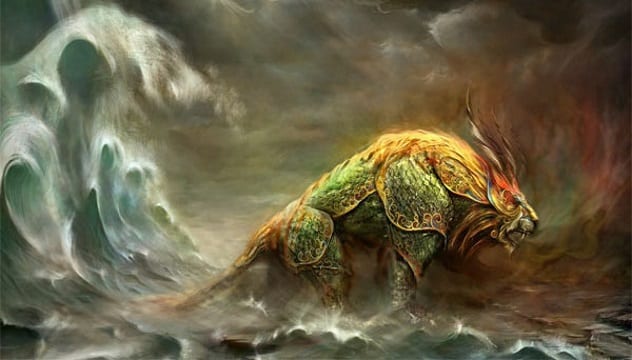
Everyone knows of the vibrant and fortune-filled celebration of the Chinese New Year. According to legend, the tradition, which is honored worldwide as a festival of new beginnings and good luck, began as a means of self-defense.
In ancient China, a Taoist monk by the name of Hongjun Laozu came across a small village and noticed the people boarding up their doors and windows. They explained that they were preparing to hide from the Nian—a creature that lived high up in the mountains and descended once a year to eat their crops, livestock, and children.[8] The Nian had the body of a bull and the head of a lion and was as ferocious as both. For generations, the townspeople lived in fear. Each year, when the Nian descended from the mountains, they were left to his mercy, or lack thereof. Laozu could not bear to see the people cower in such a way, so he ascended into the mountains that very evening. In the night, Laozu mounted the Nian and rode him to the brink of exhaustion, thus sparing the village for a time.
The text three nights, Laozu continued to tire the beast, until he himself grew weary. Laozu explained to the people that they must learn to tame the Nian themselves. The people believed this to be impossible . . . until, that is, Laozu explained that the beast is afraid of three things: the color red, fire, and loud noises. That night, the villagers bedecked their town and their bodies in red, set off fireworks into the sky, and stayed up celebrating the fear of the beast. Since then, the Nian has not descended from his home in the mountains, and the Chinese New Year has come to symbolize a celebration of new beginnings and good fortune.
2 Fairy Changelings

Not to be mistaken for their benevolent counterparts, the fairies of Scotland and Ireland are a far cry from the Tooth Fairy. These fairies, while not innately wicked, are tricksters at best, and if you aren’t careful, you may end up becoming their victim. These fairies have a particular penchant for swapping out human babies with one of their own.[9] When the mother is not looking, the fairy changelings creep in and kidnap her child; in its stead, they leave a fellow changeling—unless, of course, the fairy chooses to leave a bundle of sticks or an old log instead.
Often, the imposter is content simply to eat and drink its days away, much like a human baby would. The changeling will remain in the care of the mother until she figures out otherwise and tricks the changeling into revealing itself. If, indeed, your baby has been switched for a changeling, the quickest way to draw out its true form is to boil water in halved eggshells. Once the baby sees this ridiculousness, it will laugh and howl with delight—the first sign of happiness that it has shown since settling into your home. Upon reveal, you can then chase the changeling fairy out while its kin place your baby back in the crib.
1 Tengu
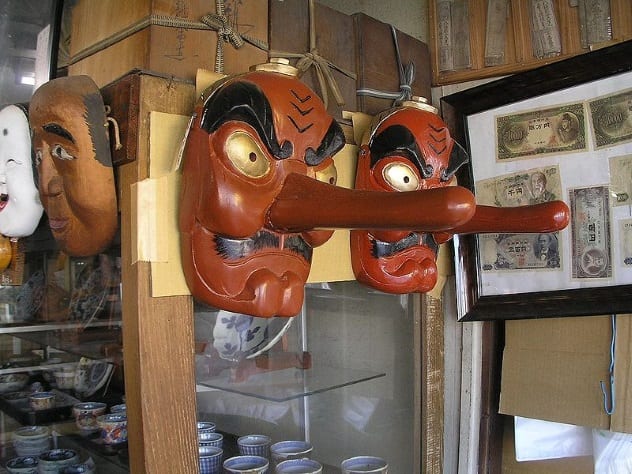
Hailing from Japan is the flying, goblin-like monstrosity known as the tengu. A mythical demigod demon, the tengu is capable of flying and running great distances at incredible speeds. One can identify a tengu by its fiery red skin, extremely long nose, and haughty nature; if one fails to treat the tengu with the respect it feels it deserves, then that person will surely become the tengu ‘s next victim.
When not avenging its honor, the tengu can be found preying upon those on the Buddhist journey toward enlightenment.[10] Many believe that tengu are the restless spirits of former priests and heretics who were wronged by members of their faith and seek revenge. As such, tengu can often be found kidnapping monks, robbing temples, and possessing women so that they tempt holy men to break their vows. If one were so unfortunate as to come across a tengu, it would be impossible to outrun or fight the demon due to its magical martial arts abilities.
Read about more creepy monster legends on 10 Evil Winter-Dwelling Beasts From Folklore and 10 Bloodsucking Monsters From World Folklore.







